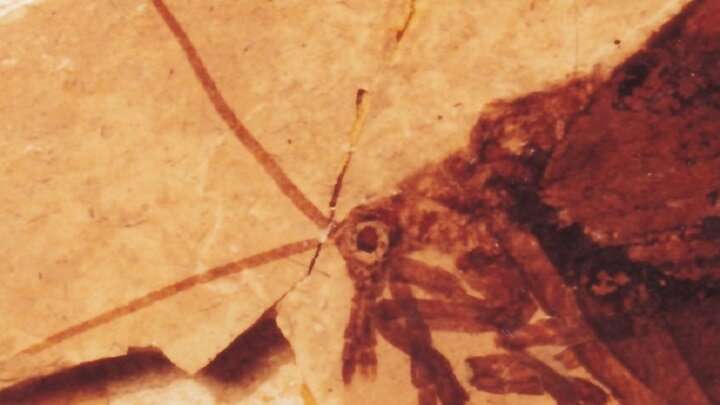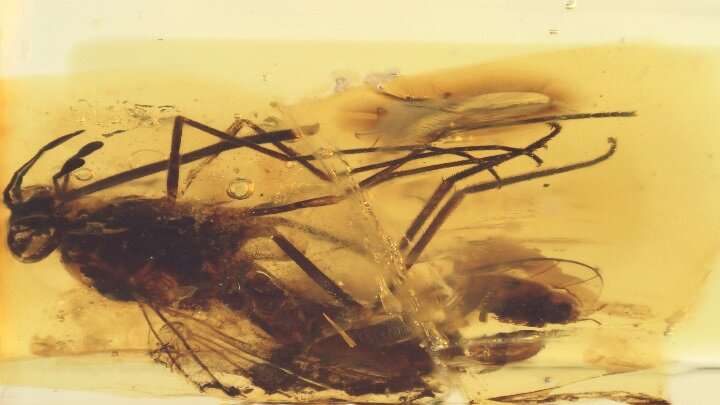Study determines criteria for differentiating a pollinating insect from a presumed pollinator in the fossil record

Insect pollination is a decisive process for the survival and evolution of angiosperm (flowering) plants and, to a lesser extent, gymnosperms (without visible flower or fruit). There is a growing interest in studies on the origins of the relationship between insects and plants, especially in the current context of the progressive decline of pollinating insects on a global scale and its impact on food production.
Pollinating insects can be recognized in the fossil record, although to date, there has been no protocol for their differentiation. Fossil pollinators have been found in both rock and amber deposits, and it is in rock deposits that the first evidence of plant pollination by insects is being studied across the globe. But how can we determine which was a true insect pollinator in the past?
A study published in the journal Trends in Ecology & Evolution determines the criteria for differentiating a pollinating insect from a presumed pollinator in the fossil record. This new study, which will facilitate the correct analysis of the origin and evolution of insect pollination, has been led by the doctoral student Constanza Peña-Kairath, first author of the paper and member of the Faculty of Earth Sciences and the Biosiversity Research Institute (IRBio) of the University of Barcelona. Peña-Kairath is working on the thesis under the supervision of Professor Xavier Delclòs (UB-IRBio) and researcher David Peris (Botanical Institute of Barcelona, CSIC–Barcelona City Council), who are also co-authors of the work.
Other experts from the UB-IRBio, the Spanish Geological and Mining Institute (CN-IGME CSIC), the American Museum of Natural History in New York (United States) and the University of Northampton (United Kingdom) have also participated in the article.
When 'gymnosperms' dominated terrestrial ecosystems
Today, angiosperms dominate most of the planet's terrestrial ecosystems, but this has not always been the case: flowering plants appeared during the Lower Cretaceous and diversified during the Upper Cretaceous, about 100 million years ago, replacing forests dominated by "gymnosperms" (conifers, ginkgoes, cycads, etc.).
"Angiosperms are considered to have interacted with pollinating insects (a mutualistic relationship, with mutual benefits) since they appeared on the planet. Their first pollinators were probably generalist insects (beetles, thrips, flies, etc.) that had previously pollinated 'gymnosperms.' In fact, several fossils are known in Cretaceous amber in which pollinating agents were probably already present," says Constanza Peña-Kairath, member of the UB Department of Earth and Ocean Dynamics.

How to classify an insect as pollinator?
Studying such a complex process as insect pollination through the fossil record is a challenge in paleontology. In order to identify a pollinating species that inhabited past ecosystems, it is not possible to perform the analyses that are currently applied to organisms found in the natural environment (e.g., analysis of increased fruit formation on certain plants if visited by certain insects, etc.).
"Therefore, it is necessary to define when a fossil insect can be considered a pollinating agent and thus establish a whole set of key characteristics that can also be observed generally in fossils," says Peña-Kairath.
The study has identified 193 insect families from ten different orders that are considered to be pollinators of angiosperms and "gymnosperms." The authors have also established when they appear in the fossil record and have produced a classification of the fossil insects that have been described as pollinators to date.
By combining these scientific data, the team has developed a key to differentiate fossil insects into two categories—pollinator and presumed pollinator—and thus rule out those that do not show enough evidence of this type of mutualism with plants. Thus, in order to classify a fossil insect as a pollinator, the arthropod must have pollen grains attached to its body and belong to a group of present-day insects considered pollinators, among other characteristics.
Using the analysis of the entire fossil record, it is clear that all current insect orders with some pollinator species existed before the appearance of angiosperms in the Lower Cretaceous. There are even examples of insect groups that were pollinators during the Cretaceous—such as the Mecoptera or scorpionflies—but that no longer have pollinating species today.
The oldest fossil record of pollination
The conclusions of the study suggest that the earliest record of the mutualistic relationship involving insect pollination relates to an extinct group of Neuroptera insects and it originated at least in the Late Jurassic—some 163 million years ago—long before the emergence of the first flowering plants.
"This information is highly relevant because it reveals that insects have had a close relationship with gymnosperms since ancient times. Therefore, it comes as no surprise that some of these plants continue with this beneficial relationship today," conclude researchers Xavier Delclòs and David Peris.
More information: Constanza Peña-Kairath et al, Insect pollination in deep time, Trends in Ecology & Evolution (2023).
Journal information: Trends in Ecology & Evolution
Provided by University of Barcelona




















